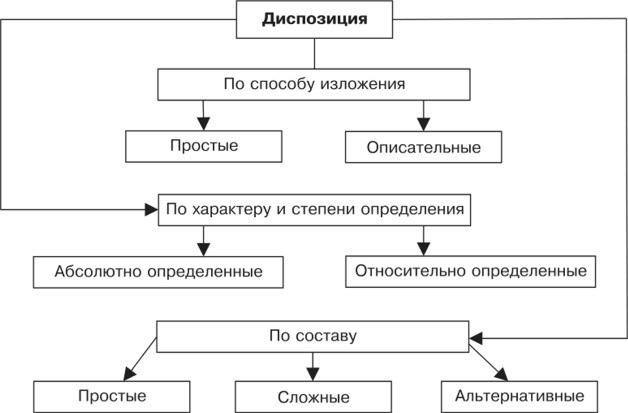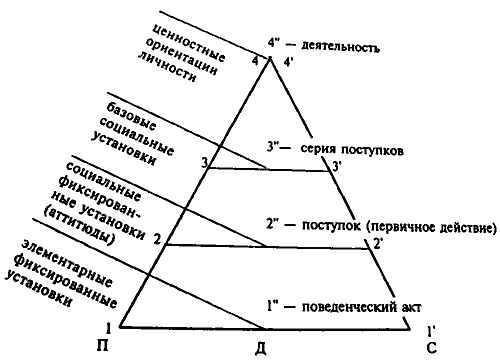Content
- The concept of disposition in psychology
- Structural elements of the theory
- Personal dispositions
- Common behavioral traits
- Proprium
- Conscious constituent of personality
- Systemic dispositional approach to the study of personality and its properties
- Systemic dispositional concept of an integral personality
- Personal dispositions in psychosomatic disorder
- Strengths and weaknesses of the dispositional concept
- Examples of dispositions in psychology
- Dispositions of protective and coping behavior of the individual
- Disposition video
Disposition or disposition of a person to a particular reaction in psychology is an important aspect that helps to understand the whole picture of the personality and its values. More details about what are the dispositions and how they affect the life and health of the individual - later in the article.
The concept of disposition in psychology
The concept of disposition emerged in the American psychology of personalism. Unlike the more popular French theory of personalism, which is based on the premises of social and philosophical theories, the American personalism is a phenomenon that has arisen on the verge of different psychological schools, such as behaviorism, the theory of personality traits and various humanistic theory.
Disposition in psychology is from the Latin "disposition". She was one of the main factors in the assessment of personality traits proposed by Gordon Allport. He, without refuting the main ideas of behaviorism, argued that personal predisposition helps to understand the complete picture of human behavior, and not just the study of his impulsive response to a stimulus.
The idea of the concept of disposition means an internal predisposition of a person to a certain model of behavior in a particular situation. This model includes not only the impulsive personality response provided by the behaviorists, but also awareness, motivation, willpower, personal inner qualities and numerous human traits.
According to Allport, having studied the complex of the predisposition of a human reaction, one can predict his reaction to the external environment. Thus, conditioning the idea of disposition in psychology, Allport tried to expand the ideas of behaviorists and social psychologists about the ability to predict human behavior and its potential danger to society.
Structural elements of the theory
Dispositions, or character traits in psychology, are one of the four structural components of personality psychology according to Allport's theory. Together with such elements as general traits of behavior, proprium and conscious component, the disposition of the personality allows us to understand a detailed picture of the character and behavior of each person.
Personal dispositions
Personality traits, or dispositions, according to Allport, are the most important element in understanding a person's personality. A psychologically healthy person is proactive, that is, she consciously strives for a goal. All personality traits of an individual are determined by neuropsychic structures that have arisen as a result external stimuli and internal adaptation of a person, that is, his conscious and traumatic personal experience. Thus, a certain pattern of behavior arises, which is repeated in the future in such situations.
Personal dispositions are the key to a complete understanding of a person's individuality, his main principles of behavior and peculiar habits inherent in each individual. It is important to understand that personal dispositions are not manifested in all situations, but are observed only during a specific situations, short-term stresses that require a reaction or only in a certain environment, for example, in a circle loved ones. Personal dispositions exist latently and appear out of necessity.
Common behavioral traits
General features of behavior are inherent in all members of a certain society, culture or historical period. They often form norms and morals, and are part of the behavior of each person, but they do not communicate anything specific about him as a person. Unlike disposition, general personality traits are universal manifestations of behavior and perception, with varying degrees of expression. Examples of common character traits are: humanity, tolerance, acceptance, kindness, and assertiveness.
Proprium
If the general features and dispositions of a person are a combination of certain individual personality traits, then the proprium in psychology personalism represents the concept of the totality of all character traits, the commonality of the ways of behavior and perception of the world by man. 
 That is, when it comes to a proprium, it means a holistic picture of all human properties, their relationship to each other, and not something separate. From the point of view of Allport, the presence of clear properties of the proprium in a person is a sign of a mature personality.
That is, when it comes to a proprium, it means a holistic picture of all human properties, their relationship to each other, and not something separate. From the point of view of Allport, the presence of clear properties of the proprium in a person is a sign of a mature personality.
Conscious constituent of personality
A conscious component of a personality is an element of a personality structure that describes a different degree of a person's understanding of his own reactions, the ability to control and change them.
Systemic dispositional approach to the study of personality and its properties
Disposition in psychology is the key character traits that predispose a person to a particular action. Allport argued that in order to understand a person, it is necessary to correctly identify 5 to 10 characteristics among many inherent in everyone (he also argued that any person has more than 1000 characteristics).
For a structured personality analysis, Allport identified 3 main categories of traits, the understanding of which helps to form an overall picture of an individual's behavior:
| Examples of dispositions | Description of dispositions |
| Cardinal dispositions | These are strong traits that affect a person's behavior and destiny. They are not inherent in all people, but inherent in authoritarian and purposeful individuals. Such personalities are unique cases such as Machiavelli, Don Juan, Leopold von Sacher-Masoch, Alphonse de Sade, Don Quixote, Narcissus, Jeanne D'Arc. The cardinal disposition, if it is inherent in a person, is a fundamental motivation for behavior, has an idealistic coloring, therefore the methods are justified by the achievement of the goal at any cost. This type of disposition is inherent in a small number of people. All examples of historical and literary personalities described by Allport are both unique and universal. So, for example, only Don Quixote behaved in an idealistic, quixotic manner, but certain features in the form of a central disposition, that is, less categorical, can be expressed in many personalities. Also the example of Jeanne D'Arc - no one has yet surpassed her religious aspirations, but her image is characteristic of many to one degree or another. |
| Central dispositions | Central dispositions are the most pronounced qualities of a person that a friend, close acquaintance or relative can highlight in order to describe a person's personality. These are character traits that are inherent in most people in a clearly expressed form in certain situations (in the family circle, at work or in communication with children). This may include such character traits as: kind, affable, assertive, independent, grumpy, sentimental, cynical, touchy, dramatic, humorous, lazy. All of them manifest themselves in limited situations, that is, a hardworking person may be at work, but at home he ignores his duties. Also, a person can be friendly with his friends, but grumpy with strangers (and it is the quality of friendliness that is disposition). Central dispositions constitute a set of typical traits of an integral personality. Allport argued that each person has, on average, 7 central dispositions that shape their individuality. |
| Secondary dispositions |
These are the categories of properties and personality traits, the least noticeable in his behavior. Usually, their presence in a person's character can be determined after a long acquaintance. Secondary dispositions are rather some nuances of habits that are invisible to a stranger. They can be important in shaping the behavior of an individual. On the one hand, secondary dispositions are manifested in a person's belonging to a certain group, passion for a certain hobby. On the other hand, it can be individual preferences in food, style of dress, order, or music. |

These levels of personal dispositions are conditional characteristics of a person, where cardinal dispositions are the brightest and not inherent in everyone, the central ones govern adaptive behavior of the individual, and secondary dispositions are not immediately noticeable, and more often reflect a person as part of a certain culture or society, give a sense of unity with others.
Systemic dispositional concept of an integral personality
Almost all known character traits, such as kindness, assertiveness, purposefulness, piety, friendliness, and others, can be either cardinal or central or secondary disposition. Only from the perspective of a personal analysis of the system-dispositional concept can one characterize how this or that character trait manifests itself in a person. For example, the more pronounced a feature, the more central it is.
Disposition in psychology is a person's readiness for action and an assessment of the situation, which are due to previous personal experience. Thus, different aspects of human command form a dispositional concept - a system that characterizes social behavior and a person's level of awareness.
It allows you to establish relationships between different aspects of the study of personality behavior, such as: sociological, socio-psychological and general psychological approach. Also, for a deeper analysis of the concept of dispositional analysis, the higher, middle and lower levels of dispositions are distinguished.
This dispositional concept of personality has a hierarchical system of manifestations:
- highest component - the value system of the individual, the concept of his life, personal attitudes, the degree of need to merge with society;
- average level - a system of social attitudes, ethical norms of behavior, describing the diverse aspects of human relationships;
- Lower level - situational social attitudes, on the basis of which a person evaluates what is happening and acts.
Of all the three levels, only the higher dispositions are the most stable, and they most affect the dispositions of the lower levels. On the other hand, despite the impact of the highest value system of the individual on his behavior in certain situations, there is also a high the probability that, on the basis of a new social experience, a person in the process of adaptation to changed conditions will develop new components of higher disposition.
The basis for such a process is the rethinking of new experience and the necessary level of reflection.
Personal dispositions in psychosomatic disorder
Recently, the results of research from the field of personality traits have been actively used in clinical observations of the treatment of various diseases. Such a connection between the mental state and the physiological functioning of the human body is an area of interest for psychosomatics.
Thus, the use of the dispositional approach in studying the influence of a person's personality traits on his disorders has found numerical confirmation. According to these observations, the characteristic personality traits that indicate the maturity of the psychoemotional human conditions, are a good resistant factor to the development of disorders and the occurrence of chronic diseases.
This includes personal characteristics such as:
- emotional maturity;
- intellectual development;
- self-control level;
- authenticity, sincerity;
- adequacy, calm attitude;
- lack of guilt;
- social introversion.
On the other hand, personality dispositions have also been identified that contribute to psychosomatic disorders.
These include:
- low emotional stability;
- high anxiety and overcontrol;
- tendency to tightness;
- excessive attention to the problem;
- negative thinking.
The identified personality dispositions are important aspects of a person's psychological adaptation, both to the onset of the disorder and in the process of treating the disease.
Strengths and weaknesses of the dispositional concept
Disposition in psychology is an important aspect of analyzing the understanding of personality, which at one time allowed researchers to focus not only on human reactions, but also on other factors, such as genetic and environmental exposure, where the factor of genetic predisposition plays a key role.
Thus, the strong point of Allport's dispositional concept of personality is a detailed analysis of human traits, which makes it possible to draw up a complete picture of individual reactions and behavior.
On the other hand, the statement that from the point of view of the dispositional concept of personality there are no two the same people, complicates the use of this theory in practice and requires good skill in its use. Moreover, according to factor analysis, it is difficult to predict which features will be dominant in a given situation.
Examples of dispositions in psychology
Such a dispositional approach in psychology helps to understand the main trigger of the actions that each person commits. People with highly developed dispositions of character are often not afraid to ignore the accepted rules. behavior, if they are outdated or they are more efficiently ready to solve the problem than it was customary before. Also, an example of a developed disposition is a clear ability to understand one's own abilities and rely only on oneself.
From the point of view of the dispositional approach, this or that human behavior should be aimed at personal benefit, which at the same time does not mean that this decision should harm others. Such an analysis of human behavior, based on his disposition, will more clearly help to understand the true values of a person and reveal his willingness to look for predispositions to the environment.
The disposition has a variety of examples. In psychology, according to Allport's theory, a portrait of an integral and adult personality should correspond approximately to the following description - this is a person, who knows how to look at himself from the outside, he has the ability to warm social relations, the presence of emotional stability and self-acceptance.
Also, an important disposition is a realistic perception of the world, the ability to analyze one's own experience, the presence of a sense of humor and the presence of one's own clear position in life.
Dispositions of protective and coping behavior of the individual
Dispositions in psychology represent various aspects that affect human behavior and perception. Depending on the degree of development of a particular trait, that is, the disposition to react, we can talk about dispositions of protective and coping behavior people who represent a stable model of behavior in stressful situations, that is, the ability to maintain a positive attitude, regardless of external factor a.
So, for example, the most striking examples of defensive dispositions are such actions as:
- blocking of information;
- establishing control over events;
- mental transformation of the features of objects and objects, ignoring or displacing destructive influences;
- increase in distance.
All these strategies of dispositions of protective and coping behavior are carried out at three levels of human interaction with the world: cognitive, emotional and behavioral.
Disposition is an important aspect of the overall picture of human behavior. In psychology, this personality predisposition also allows us to talk about such important elements as development self-regulation skills, as well as predict behavior in society, depending on the prevalence and certain features in people.
Disposition video
Dispositional theory of personality:



